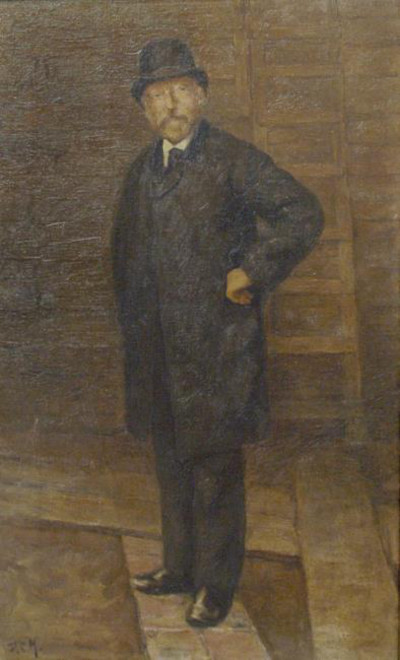This portrait of Egbert Kuipers is dated to around 1900-1901 and in that period Piet Mondrian would complete a good number of artworks within that genre. Many remain completely unaware of his work with portraiture, though a catalogue raisonne in 1998 helped to remind us of them.
In front of us here we find Egbert standing in a smart suit with a winter coat over the top. His shoes are black and shiny, and he also sports a bowler hat which sits tightly on his head. His left arm points out with his hand then wresting on his hip as he leans slightly to the other side. His other arm is hidden behind his back entirely. A small window offers us a glimpse of a white shirt and black tie, but he appears to be dressed for a journey outside. His whole outfit is black, giving us very much a feeing of an autumn or winter afternoon. He looks directly at us with a fairly relaxed expression. The artist captures him full length, with some subtle details for the background which itself is delivered in a combination of brown tones, with a fractured floor design. We can just about make out where the floor meets the wall behind him but it is done softly, so that the main portrait remains in our focus. Mondrian was working hard on his portraiture at this time, attempting to seek acceptance from academics for his technical abilities.
The painting would end up in the ownership of descendants of Egbert Kuipers suggesting that he had commissioned and paid for the piece himself. After passing they then would have received it before then selling it on themselves later on. It has since been gifted to The Israel Museum in Jerusalem and it is believed to still remain there today. This makes it one of the very few items from Mondrian's career to be found in that part of the world, with most still residing within the US and Europe. Indeed, most of the artist's earliest work still resides within his native Netherlands, amongst a variety of private and public collections. Many of his early paintings were landscapes of local scenes and so there remains a stronger interest within the country than elsewhere. On the international stage he is still much more famous for his abstract paintings which would follow on in the later decades.
The painting is listed as being 51.5cm in width and 82.5cm in height. Mondrian rarely went beyond one metre in width or height and kept fairly consistent in the sizes of his paintings. The later abstract pieces for example would always be around 50cm in height and width, often with a small border or frame behind to protect each work. The artist is known to have signed Portrait of Egbert Kuipers with P.C.M. in the bottom left corner, but later in his career he would simplify this to just PM instead, normally with the date of each work alongside. Some of his other related artworks included two self portraits in 1900 and 1918.




